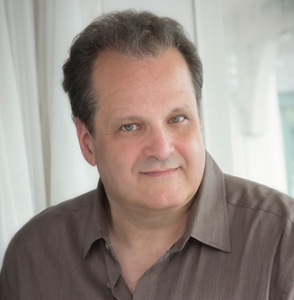In November, Alan Toltzis was invited to speak with Professor Cheryl Lester’s class on Jewish American Literature & Culture at the University of Kansas. The class read “Clearing Ivy” and submitted questions to the author; the students’ names appear with each question. Cheryl Lester is on the faculty of the English and American Studies departments at the University of Kansas and specializes in 20th-century US literature and culture. Recent publications have appeared in Fifty Years after Faulkner: Faulkner and Yoknapatawpha; Critical Insights: The Harlem Renaissance; Critical Insights: The Sound and the Fury; The Faulkner Journal; Approaches to Teaching As I Lay Dying; Faulkner and His Critics; and A Companion to William Faulkner.
Hannah Feldman: What inspired you to write “Clearing Ivy“? Was it a specific location or genre of poetry that inspired it?
Alan Toltzis: I wrote the poem at the beginning of the year, when the idea of new-year resolutions was fresh in my mind. Like everyone, I have habits and I saw ivy as a metaphor for how a habit takes hold and how difficult it is to free yourself once it does. I’ve removed ivy twice—once when it was overtaking a fir tree and another time when it was climbing a brick wall behind a goldfish pond. Imagery from both instances worked their way into the poem. As for genre, I love renaissance poetry and this is as close as I can get to a metaphysical conceit.
Elena Pratt: What does the poem mean to you?
It’s a reminder of how vulnerable we are and how much we are at the mercy of our weaknesses. Even when you break a habit, you’re never the same because the habit has changed you.
Hannah Feldman: What is/was your process for writing this poem/poetry in general? How long did it take you to write this poem?
The main work for most of my poems takes place over a few weeks with some minor fine-tuning afterwards. I often use images I’ve carried with me for decades before they work their way into a poem. I work in books and write according to a plan or outline. So, while I knew this poem was going to be about a particular kind of endurance, it was just good timing that it coincided with the new year because it worked well with the idea of resolutions.
Alexa Schmidt: Do you start a poem with an intention in mind, or do you begin with a feeling and see where it takes you?
AT: For the poems that I’ve written over the last 3 years, I always begin with an intention in mind. However, once I start the writing, the poem can take me in different directions than I originally intended. Part of the finished work comes from the original intent and part from the power that the words and images have on me and the poem. A lot of the internal rhyme in my poems come from the power and influence one word can have on another.
Savannah Pine: In the other works we read, you use mostly use quatrains. Why do you use a different form with “Clearing Ivy?”
AT: Form always follows function for me. In most poems, the lines and stanzas come from the natural flow and phrasing of the language and the words at the end of a line always have special emphasis. A poem’s organization can have a significant effect on its meaning and should help the reader understand the work better telling the reader how the poet hears his own poetry. Occasionally, I write in traditional forms (villanelles, sonnets, quatrains, quintains) because that’s what the poem requires or because the form pushes the poem where it needs to go.
Alexa Schmidt: How do you decide where to break lines?
AT: Line breaks can come about in a few ways. They break where it is natural, in terms of meaning and phrasing. But for set forms, the rhymes and rhythms have a lot to do with how lines break.
Robert Curtis: You are clearly referring to nature taking over human structures as a form of slow ruin. You refer to the inevitable not having to happen quickly. That said, is there something specific you are referring to when you say the “inevitable”?
Yes, I often make parallels between nature and human nature. When something or someone has complete control of a situation or complete mastery over you, it can do whatever it wants, whenever it wants and for me that is very powerful. I think the line works because “inevitability” is such an abstract concept but it seems almost human in the poem because of the conceit.
Kit Rice: What do you attempt to draw from your audiences? What kind of reactions or emotions? What about for this specific poem?
Whenever I write, I try to make the language so precise that the reader can experience my exact emotions and experiences through the words on the page. The reader only the words on the page and my responsibility is to make sure that every word I wrote is the right word, nothing more and nothing less. For “Clearing Ivy,” I’d like it if readers can feel themselves being pulled decline and decay of their own personal habit and the struggle they have had pulling themselves free.
Kit Rice: Did you intend for the ivy of this poem to represent anything in particular? It has the characteristics of many things (namely illness, time, and death). This poem had a fairly ominous tone to it. Can you speak to what inspired this poem?
It’s a metaphor for habit or vice. The way it sinks in and grips until it can take over your life if you’re not careful. I had a particular habit of mine in mind but it doesn’t matter what the habit or vice is because the feeling to giving in to a habit is universal.
Madeleine Moore: What is your writing process when composing a poem? Is it structured with a base idea that you build up and around, or more free flowing and spontaneous?
I wish my work more free-flowing and spontaneous but it’s just the opposite and I have to be careful not to overthink. I start with an idea that I want to write about, which for “Clearing Ivy” was endurance, willpower, and determination. Once I decide on the idea, I tend to experience the world through that particular lens and then I meditate on it. That process leads to a few words, an image, or an event that I am able to connect with the idea for the poem. From there, it’s a matter of the hard work—putting the right words down, refining, and rewriting until I’m satisfied.
Seth Miller: You make use of interesting line breaks and white space. Do you think this tends to distinguish your poetry (at least the poems that make use of such devices) as a more visual than oral medium? And sort of following on that – what about font, exact typesetting, coloring – do you care about these sorts of things, and are you ever slightly bothered by the choices a particular publishing venue makes?
I’m very sensitive to type and layout and think visually but the sound and rhythm of a poem must work too. The visual aspect adds another dimension. For instance, in my poem “Questions and Answers,” the first section is shaped like a question mark. But sound comes first and I read my poems out loud when I’m working on them.
Seth Miller: Your other poems seem to all have a link (though sometimes obscure) to religious ritual (parashiot, sefirot haomer, etc). Is there anything religious to which “Clearing Ivy” alludes?
“Clearing Ivy” is from a series of 49 poems that are loosely based on a Kabbalistic concept that mediating on each of the 49 aspects of conscious human emotion, during the 49 day between the second day of Passover and Shavuot can elevate consciousness and awareness, refining the soul. The poem was written to correspond with a specific aspect of the emotion of endurance that has to do with willpower and determination.
Hannah Silverman: How would you say you’ve gotten your start as a writer? Did you start out as a poet, or did you evolve into one?
Purely by accident, I took a class in modern poetry at Temple University that was taught by Thomas Kinsella and then took a few other classes and workshops he taught. That’s the course that opened up poetry for me and I consider Mr. Kinsella to be the man who taught me how to read. I never stopped reading intensely, using the approach he taught me. To write a poem, you have to read.
Hannah Silverman: Which biblical figure do you identify with while writing? (In reference to the Noah poem, where did your influence come from?)
A handful of the poems in “The Last Commandment” are about Biblical characters. Instead of looking at their iconic nature, I think of them as everyday people, which led me to the examine things like the letdown Noah experienced after the flood. In “Elegy for Sarah,” I have lines about the private sorrow Abraham felt when Sarah died. And in “Spectra,” I focus at how Jacob, at first, missed seeing heaven in the story about Jacob’s ladder. Once I have the insight, I try to make it personal.
Hannah Silverman: Would you rather live in a dry heat, or frigid cold climate?
Give me hot weather any time. For me there’s no better feeling that heat sinking deep into me. It probably comes from hearing my mother say how the heat never bothered her. . . until our house got central air.



Pingback: “Clearing Ivy” by Alan Toltzis | Rkvry Quarterly Literary Journal